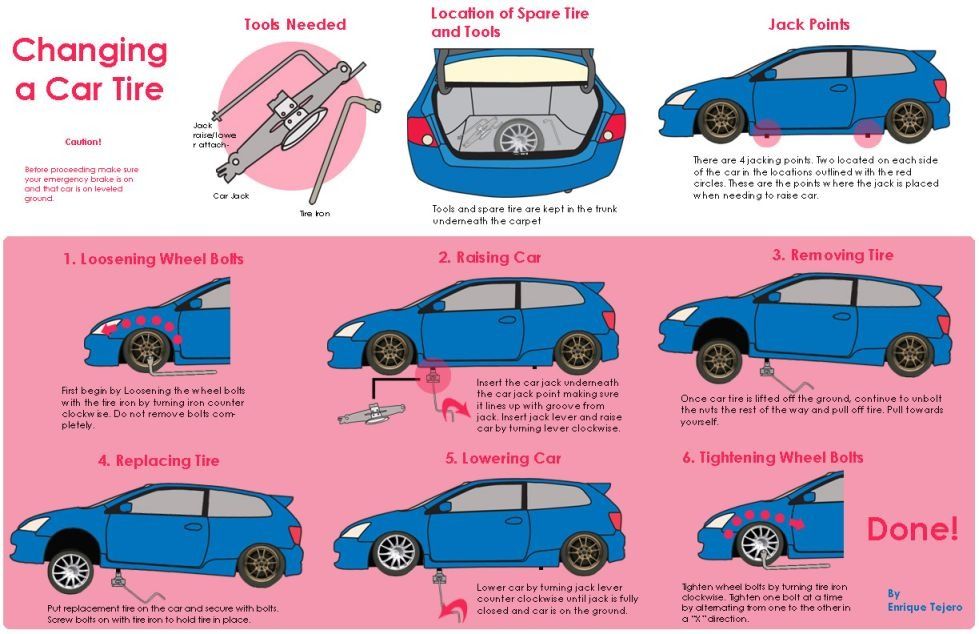I just bought four brand new tires for my car but I haven’t had the chance to get them installed. I want to have them installed during my lunch break tomorrow, but I’m concerned I won't have my car back in time. How long does it take to get new tires installed?
Kara Vanderbeek · Answered on Mar 04, 2022
Reviewed by Shannon Martin, Licensed Insurance Agent.
In general, it will take a professional ten minutes to change a tire. With four tires, you’re looking at roughly 40 minutes. Having your tires changed by a professional will be the most efficient, as they have the most advanced tools and skills to do the job.
However, when you are replacing all four tires, you may need to have them checked for alignment and wheel balancing to make sure your car won’t vibrate while you’re driving. This process may add an additional 45 minutes to the installation.
To be on the safe side, allow yourself at least one hour for the installation, alignment, and wheel balancing checks to be complete. You’ll be back on the road in no time!
Before you hit the road with your new tires, make sure you have the right car insurance to protect you from any unexpected incidents. Car insurance super app Jerry can help you with all of your insurance needs.
MORE: [The best all-season tires for snow] (https://getjerry.com/advice/best-all-season-tires-for-snow)
Car MaintenanceCar Tires
View full answer
WHY YOU CAN TRUST JERRY
Jerry partners with more than 50 insurance companies, but our content is independently researched, written, and fact-checked by our team of editors and agents. We aren’t paid for reviews or other content.
Browse More Content
How To Get an Inspection if Your Emergency Parking Brake is Stuck
Canister Purge Solenoid Replacement
What To Do If Your Wipers Are Not Working
Brake Pedal Is Lower Than Usual Inspection
Exhaust Gas Recirculation (EGR) Tube Replacement
Audi S4 Quattro Insurance Cost
Gmc Yukon Xl K1500 Sle Insurance Cost
Kia Spectra5 Sx Insurance Cost
Ram 2500 Powerwagon Insurance Cost
Tesla Model S 70D Insurance Cost
Meridianville Car Insurance
Corpus Christi Car Insurance
Woodsboro Car Insurance
Dedham Car Insurance
Pevely Car Insurance
 Should I get one?
Should I get one?I live in a rural area and last year a dear totaled my Ford Focus. I have a Ford Fusion now, and I was wondering if I should invest in a Ford Fusion push bar. Would that change my insurance at all?
Matt Terzi
Mar 04, 2022
I’ve got a 2000 Ford Lightning that just won’t quit. I want to replace the headlights, but I’m wondering, can I upgrade my Ford Lightning headlights? Or should I just go with regular factory-style headlights?
Matt Terzi
Mar 04, 2022
I bought a 2019 Ford Explorer this week so I could join my friends for some back roads camping adventures. Do you have a recommendation for Ford Explorer off-road tires I should get?
Matt Terzi
Mar 04, 2022
Browse All Questions
The basic Texas CDL requirements include a valid Texas driver’s license and a clean record with no major driving violations.
R.E. Fulton
Oct 05, 2022
With the release of Honda’s much-anticipated CR-V just around the corner, here’s everything we know about the possible PHEV option.
Brittni Brinn
Jul 15, 2022
Looking for the 2010 Dodge RAM 1500 bolt pattern? We’ve got everything you need to know.
Matthew Lynaugh
Aug 23, 2022
Comprehensive Coverage
VIN Lookup
Car Rentals
Cadillac
Liability insurance
Company Cars
Loan Discounts
Insurance Shopping
Water Damage
Mileage
Car Down Payments
Toyota
Cheap Auto Insurance
Add a Driver
Private Sales
Car Insurance Companies
Drivers with Disabilities
The General
Scooters
Consigners
Title Transfers
Fleet Sales
Home and Auto Insurance
Ridesharing
State Laws
Subaru
Emergency Brakes
No long forms
No spam or unwanted phone calls
Quotes from top insurance companies
Find insurance savings — it's 100% free
Toyota
Hyundai
Mercedes-Benz
Subaru
Chevrolet
Mitsubishi
Tires are absolutely an essential part of a vehicle, so it is advisable to draw attention the tire care on a regular basis. All functions will run evenly. However, most car owners are not sure about the time of tire replacement. How long does it take to change tires? It depends on the situation. It could be 40 minutes for 4 tires.
All functions will run evenly. However, most car owners are not sure about the time of tire replacement. How long does it take to change tires? It depends on the situation. It could be 40 minutes for 4 tires.
There is one point you should know is that vehicles were built of steel (not aluminum). The tire is not a balanced tread when it comes to 10grams. These days, people use the tire lighter, which is between 5 and 7grams only.
Furthermore, misbalanced weight in tires is a key issue when replacing any tire. Along with this problem, the time taken to change the tires is another task to deal with. How long does it take to change tires?
In general, tire change takes about 45 minutes for four tires. The time relies on the equipment a mechanic (or you) uses. A professional mechanic or an experience vehicle owner probably spends 10 minutes replacing a new tire. A high-quality tool improves the process efficiently, so the time might be less than 30 minutes.
Replace a new tire is a common homework that every vehicle owner should know. Whether you got great service, you still need to do the necessary task in case you are on the freeway. Here are a few things to begin with.
Find a quiet place to park like a garage or a lot in a mall. Use a tire machine to lift the tire. Then, you scan the TPMS system to identify any trouble with your wheels. By doing that way, you might estimate how long it takes to change tires.
You possibly disassemble each part of the car so that you might find out any faulty or harmful elements. Furthermore, wiping down all wheels and hub mating surfaces is a tremendous idea to decrease tires replacement time.
You should eliminate the tires. If your car contains the TPMS system with the wheel-controlled sensor directly, you would remove the sensor. After that, replace each soft part surrounding the wheels (gaskets, sensor nut, and main valve).
Get the sensor and new tires on. Remember to balance wheels within 5-6 grams. This possibly protects your vehicle in the long term.
Thereafter, put the wheels back to the car through the machine and the torque system. Check the tires again because they should have enough pressure as the manufacturer required. This is an essential part to help you out how long it takes a tire could change.
Trigger off and set up the TPMS system in the right way (if relevant). If your vehicle uses nitrogen, you should fill a certain amount of nitrogen in each tire.
Apart from the tires replacing duration, many of us also would like to know when the process needs to be done. You know; there is nobody size fits all ones. So, you need to ask for the manufacturer or find the information in the catalog. You can consult an experienced mechanic to recognize the accurate time.
Different factors also affect your tires. Your vehicle model, the tire category, the road condition, weather condition, how you drive the car determines the best time to maintain and the lifespan of the tires.
Your vehicle model, the tire category, the road condition, weather condition, how you drive the car determines the best time to maintain and the lifespan of the tires.
Furthermore, you should bear in mind the tread life and driving style. The rubber material, for instance, will decrease the tire quality faster when driving on pavements. The driving speed also impacts tire life. A fast driver is not good in this case.
In general, check wear-and-tear problems in your car even if it seems to be normal.
You do not have to become a mechanic to master tires replacement. Just follow these simple steps below.
 Do not eliminate them
Do not eliminate themHow long does it take to change tires? The time to replace a new tire relies on your car model, tools, and your current situation. On average, it will take you 40-45 minutes to complete the job. In a vehicle repair station, the time is flexible depending on the workload inside.
On average, it will take you 40-45 minutes to complete the job. In a vehicle repair station, the time is flexible depending on the workload inside.
Alvin Reyes
Alvin Reyes has expertise in automotive evaluation. He collaborated with famous newspapers and is still making efforts in tire review for DrivingPress.com
This post was last updated on The procedure for servicing cars at tire change stations can take a different amount of time. The exact figure depends on the equipment present and the professionalism of the master. On average, changing the wheels of a car at a tire fitting stretches for 20-30 minutes, in the absence of a serious workload of personnel.
Contents
In some cases, the installation procedure can take an hour or more. The exact figure will depend on the type of work performed.
The exact figure will depend on the type of work performed.
If you put new skates on the wheels, you need to count on at least an hour. The usual replacement of finished wheels is faster. A savvy master can change all discs in a few minutes.
The need for repairs also affects the efficiency of work. In some situations (vulcanization is required), the procedure may take a day.
Service stations and tire shops in Russia always try to work as quickly as possible. The salary of the master directly depends on the number of clients. Usually the procedure for changing a set of tires from summer to winter does not take more than one hour.
Usually the procedure for changing a set of tires from summer to winter does not take more than one hour.
Waiting time can be increased by factors that do not affect the immediate speed of the specialist's work - this is the queue and customer requirements.
Installation of summer tires is more difficult for the master than winter tires. This is argued by the increased rigidity of the rubber. Dense sidewalls are difficult to put on discs, which requires great physical effort.
This difference will not be noticeable to the user. Experienced technicians know how to properly place a product on the machine for fast assembly.
To facilitate the process of changing tires and speed up service, you can foresee a few points in advance and not wait in a huge queue.
 If the mechanic is warned about the visit, a window prepared for a specific car is formed at the service station. For complete confidence, you can give the mechanics an advance payment of 30-50% of the total cost of service.
If the mechanic is warned about the visit, a window prepared for a specific car is formed at the service station. For complete confidence, you can give the mechanics an advance payment of 30-50% of the total cost of service. Leave a comment
Change of seasons, cooling or warming are associated with the replacement of car tires. Car owners are faced with the choice of tire type, wondering at what temperature Velcro can be driven and how to provide optimal conditions for accident-free driving.
Car owners are faced with the choice of tire type, wondering at what temperature Velcro can be driven and how to provide optimal conditions for accident-free driving.
Summer tires are designed for positive temperatures. Winter tires are used at 7°C and below. The main differences are in the quality of the rubber, as well as in the tread pattern.
"Winter" rubber compound provides a short braking distance, good grip on snow and ice surfaces. The tread is characterized by a high density of sipes, a directional pattern, and expanded grooves. When choosing, you should consider the difference between traditional studded models and Velcro.
Non-studded "sticky" wheels are made of soft rubber, have an extensive network of grooves on the tread. Water from the road surface is distributed over the lamellas and "absorbed". The friction between the wheel and the surface increases, the car "sticks" to the road.
According to the results of testing of both variants, which was carried out in difficult conditions, the average stopping distance of a car with Velcro is 15-17% less than studded cars.
The braking distance depends on temperature, road conditions, ice conditions. The car travels the same distance from pressing the brake pedal to a complete stop on the spikes or Velcro at -15°C. When the temperature drops, it is advisable to wear “soft” tires, and when the temperature rises, studded tires.
Velcro is suitable for rough ice, because the lamellae cling to uneven surfaces. On a smooth ice field, a car with spikes will be more stable. If the sun has melted the surface, studded tires will also be more effective.
When the temperature drops to -20°C, the braking distance of the car on spikes is 20% longer than Velcro. Therefore, during severe cold weather, it is better to use “soft” rubber.
In the range from -5°C to 0°C, the braking distance of the car on the spikes will be shorter. Melt water causes Velcro to slip. The more water, the worse the grip of the wheels. In puddles, the effectiveness of any rubber is reduced. But studded tires are better for slippery surfaces.
When choosing tires, first of all, you should take into account the climatic zone of the region where you live. On frozen roads, during harsh winters, it is better to use Velcro. Spikes are more suitable for mild climates, thaws and ice.
The standard condition for changing tires is a decrease in the average daily temperature below 3°C. Consider the difference between the city and the suburbs. City streets can be dry, while rural roads are icy. Therefore, a change is necessary if the daytime temperature does not exceed 3°C.
Soft winter tires lose their effectiveness at 10°C and above. The braking distance increases, the probability of accidents increases, the comfort of travel decreases. The optimal period for replacement is from mid-October to November 15-20. The first “call” is snowfall or frost.
As a general rule, the machine must be prepared before snow or ice forms on the road. If a sudden change in temperature is expected, and the car is used intensively, put the Velcro on at 9°C. In such cases, it is necessary to avoid abrupt maneuvers, choose a gentle speed mode, and keep an increased distance.
In such cases, it is necessary to avoid abrupt maneuvers, choose a gentle speed mode, and keep an increased distance.
If the car is used irregularly, the optimum temperature for replacement is 0°C. In order not to get into an accident, you can use public transport and wait for favorable weather conditions.
Tires must be marked "M+S", "M&S" or "M S", a specific tread pattern. The requirements apply to cars of category B and trucks. The mandatory use of winter tires may be extended by regional ordinances.
The difference between spikes and Velcro is the allowed period of use. Studded models are used only from September to May. Tires without studs can be used all year round. It is necessary to change shoes from summer tires without marking to winter tires in the period September-November.
The tread depth of a winter tire must not be less than 4 mm. Wearing worn tires can result in a fine or a warning. A fine is issued only when operating a car on an ice or snow surface.